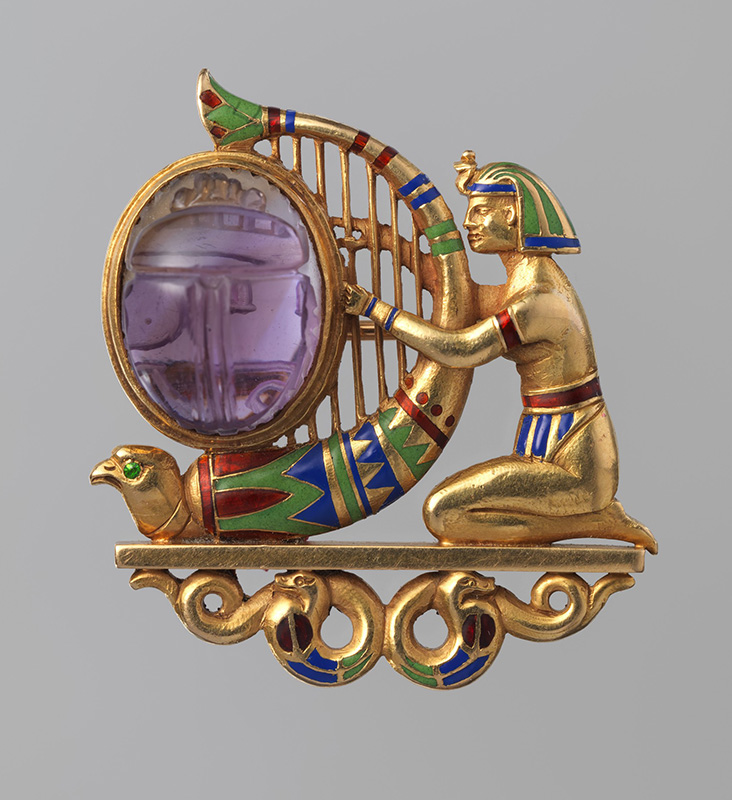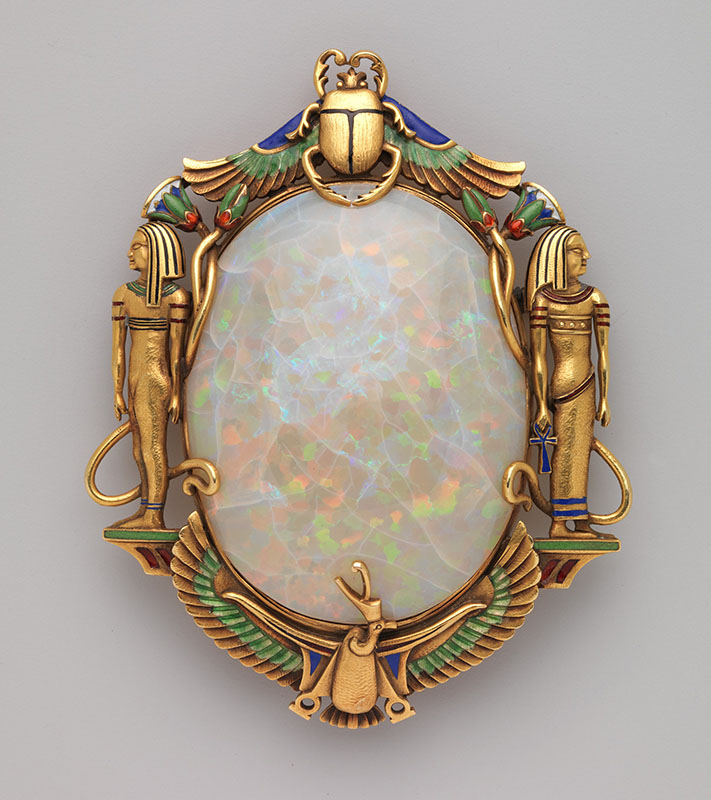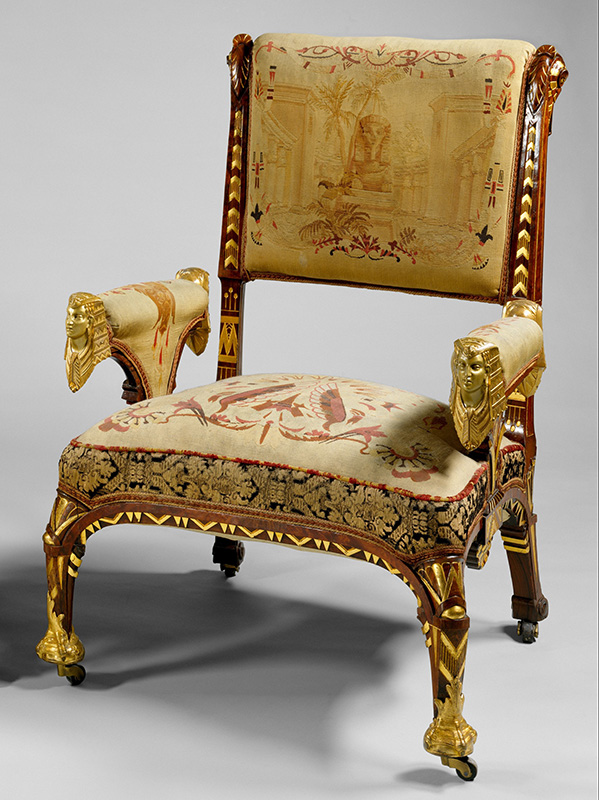Multi-Sensorial Materials: Egyptomania and the Decorative Impulse
Click on images to enlarge them and view captions.
by Lea C. Stephenson
Across the late-19th-century Anglophone world, artists and collectors fabricated Orientalist fantasies of Egypt as part of a phenomenon that became known as Egyptomania. This sensation included an embodied and material engagement with the modern North African Middle East and the ancient Islamic empire. Under this form of American Orientalism, Egypt became an exoticized vision of a non-Western landscape. For 19th-century Euro-American audiences, the ancient Egyptian past and contemporary “Orient” would often blend into an invention melding the past and the present through visuals and material culture.
Whether mummies, perfume, bottles of Egyptian sand, or portrait miniatures, Egyptomania embraced a multi-sensorial imagination. The second wave of Egyptomania (c. 1870–1922) was preceded by an earlier movement at the turn of the 19th century, sparked by Napoleon’s campaign to Egypt. Euro-American artists, collectors, and travelers interpreted the country for late 19th-century audiences amidst rising British imperialism in Egypt.
My dissertation examines how late-19th-century and early-20th-century Euro-Americans used multi-sensorial perceptions and their colonial imaginations to conceive of modern Egypt in terms of an embodied Egyptomania. Rather than simply a stylistic movement, Egyptomania became tied to cultural imperialism and 19th-century exercises of racial power. Material culture—whether antiquities, objects made recently by Egyptian hands, or American-made Egyptian Revival creations—enabled their owners to imaginatively insert themselves and their bodily presence into the region.
Thanks to the generosity of a Decorative Arts Trust Marie Zimmermann Research Grant, I visited New York collections to closely study Egyptian-inspired objects, including furniture and jewelry. The range of material produced in the United States—from scarab brooches to armchairs to Cleopatra costume attire—suggests the multi-sensorial experience of Egyptomania. A segment of my project examines portraits of elite Euro-American women who wore Egyptian-inspired dresses and jewels, and decorated their homes with similar motifs. Over the course of the fall, I examined how colonial fantasies impacted American interiors, and the ways designers re-imagined Egypt within domestic spaces.
The concept of physically wearing Egypt appeared through a variety of adornment. During second-wave Egyptomania, American firms created garments and accessories involving Egyptian-inspired designs. The periodical Godey’s Lady’s Book and Magazine noted, “All the new jewelry is strongly Egyptian in its character, and the mummies are now called in to contribute to fashion.”1 For example, the New York jewelry and silversmith company Theodore B. Starr crafted a gold brooch of an Egyptian figure playing a harp set with an amethyst carved scarab (figure 1). Marcus & Co., another New York firm, fabricated a large white opal brooch with abstracted Egyptian figurines, lotus flowers, ibises, and scarabs pulled from ancient temples (figure 2). Pinned to the wearer, fashionable, revivalist jewelry offered clients a re-imagination of Egyptian material excavated in the Valley of the Kings, and displayed at grand expositions, including the 1876 Centennial Exposition in Philadelphia. For a New York audience, Marcus & Co. or Theodore B. Starr reinterpreted the principal symbols of Egyptian antiquity, whether artifacts or architecture. These tactile accessories allowed clients to intimately interact with antiquity through materials like gold, opal, amethyst, and enamel. The act of wearing Egyptian-inspired jewelry or the sensation of a material on the skin enabled a type of imagined imperialism.
Although the United States did not explicitly establish a traditional colony in the country, the relationship between American artists, collectors, and designers and Egypt was a form of aesthetic, cultural, and economic imperialism. Simultaneously, members of a privileged social class of white, Euro-Americans identified themselves with the ancient Egyptian ruling elite and appropriated the material aesthetics of a Black civilization they cast as bygone. In this world, visual representations became exercises of imperial power, wrapped in antiquities and their representation(s). Jewelry offered a decorative tool to further create a bodily tie between the United States and a foreign, or Othered, landscape.
Adornment with Egyptian materials is also found in revival furnishings. A suite of 1870–75 Egyptian Revival chairs by the New York firm Pottier & Stymus is a principal example (figure 3). Auguste Pottier’s French background perhaps accounts for some of the European-inspired Egyptomania motifs which could be pulled from publications and media that circulated images of Egypt across the Atlantic, including Sir John Gardner Wilkinson’s Manners and Customs of the Ancient Egyptians (1837) and commercial photographs of Egyptian monuments. The arms of the chair include fantastical brass mounts of ancient Egyptian heads with the nemes, or pharaoh’s headdress.2 These cast metal mounts would reappear on other revival pieces, along with Egyptian sphinxes and hoofed feet reminiscent of ancient Egyptian furniture.3 The French Aubusson upholstery pattern on the armchair incorporates an ancient temple complex, a sphinx, and palms to evoke Egyptian scenery. The woven textile creates a composite Egyptian landscape, one distilled into motifs legible for a Gilded Age audience. Decorative details became a means of reinterpretation, even willful re-imagination, about Egypt. Although the original owners of this suite remain unknown, we can imagine them interacting with the chair’s sensorial details. They could lean back into the ancient scenery or touch the Egyptian-inspired brass mounts. The sense of touch offered escape into a fantasy of the Egyptian landscape, and a means for Euro-Americans to conceptualize the country. Putting Egyptomania decorative arts together invites us to consider how these objects could intentionally skew the relationship between audiences and an imaginary exotic, suggesting the imperial stakes of revivalist design.
- “Chitchat Upon New York and Philadelphia Fashions for March,” Godey’s Lady’s Book and Magazine, March 1866, vol. 72, 292.
- Bernadette M. Sigler, “The Egyptian Movement in American Decorative Arts,” in The Sphinx and the Lotus: The Egyptian Movement in American Decorative Arts, 1865-1935, edited by Bernadette M. Sigler and Kevin Stayton (Yonkers: Hudson River Museum, 1990), 16.
- Sigler, 18.
Lea C. Stephenson is a PhD candidate in Art History at the University of Delaware and is the Luce Foundation Curatorial Fellow in American Paintings & Works on Paper at Historic Deerfield.
A print version of this article was published in The Magazine of the Decorative Arts Trust, one of our most popular member benefits. Join today!



